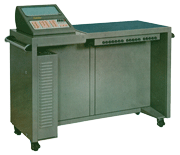Published on Dec. 15, 2017
Last updated on July. 17, 2025
Last updated on July. 17, 2025
Kashio Seisakujo, established in 1946, initially produced microscope parts, gears, and other items. Most calculators at the time in Japan worked using gears and were operated by hand. Inspired by an exhibit of electric calculators built overseas at a business show in Japan in 1949, the company set about developing calculators using relays. The first prototype was completed in 1956. Later, in June 1957, the company completed the Casio 14-A, the first commercial relay-based calculator. Casio Computer Co., Ltd. was formed at the same time.
Relays are a type of electromagnetic switch and were used in great numbers in telephone switching equipment and other applications. Relays were also adapted for the earliest computers, but due to their sensitive contacts and construction, they were normally placed inside cleanrooms with constant temperature and humidity. Casio, however, saw applications for its calculators in ordinary offices and built the 14-A calculator to be reliable and dustproof.
The 14-A was capable of performing the four basic arithmetic operations to 14 digits in an enclosure small enough to fit on a small desk. The 14-A used 341 relays and small miniature lamps for a display. Most electric calculators at the time displayed the arguments and answer in separate display windows, but the 14-A had just one 14-digit display window that worked like most of today’s calculator displays — erasing the entered number to display the answer. Another innovation was the first use of the 10-key number pad like today’s calculators. Other calculators back then had a “full keypad” with nine separate keys for each digit in the number. In addition to 14-digit addition, subtraction, multiplication, division, it was also possible to add up individual products and to add and sum up multipliers.
The machine has been improved several times since its completion, and its size and weight have changed; the 1958 catalog lists the size as 101 x 42 x 78 cm (w x d x h), weighed 120 kilograms, and cost 485,000 yen. The number of relays also varied slightly due to improvements. The calculator earned a good reputation for being quieter and faster than other electric calculators and hand-cranked calculators. It was installed at government offices, securities companies, and general affairs departments at ordinary companies. 14-A won an award from the president of Tokyo Hatsumei Kyosankai (an association to sponsor inventions)in 1958.
Casio announced the 650,000-yen 14-B in May 1959 to address demands for square root calculations for technical and statistical calculations. The 14-B was adopted in large numbers by universities, research organizations, and engineering departments.


